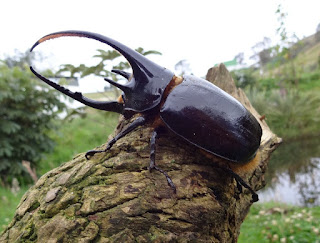
The Hercules beetle is one of the largest beetles in the world. Hercules beetles are found in Central and South America. 13 Hercules beetle species are known. They live in the rainforest, hidden in rotting tree trunks. Though very strong, the Hercules beetle has many predators. Other threats to Hercules beetle survival include deforestation (loss of habitat) and water and air pollution. The Hercules beetle is listed as threatened species.
The male Hercules beetle is black in colour, sometimes with the exception of the elytra. In a dry atmosphere, the elytra are yellow to olive green and are decorated with dark spots and fine streaks. When the atmosphere is humid, the elytra become completely black.
Size of Hercules beetle depends on the species. Length of Hercules beetle can vary from 1.5 to 6.7 inches.
Females may be entirely black in a dry atmosphere but sometimes have elytra that are partially coloured.
Smaller species live in the Appalachian valleys of Kentucky while larger species live in Honduras.
Females sometimes have a weaker ability to change colour than males, however.
Body of Hercules beetle is covered with strong shell, which acts as outer skeleton.
The eyes of a Hercules beetle are located on the sides of the head slightly below the lower horn.
Color of the Hercules beetle body depends on the species and gender. Females are usually brownish-black, while males have black head and black, brown or green body covered with black spots.
The upper horn of the beetle is called the thoracic horn, since it begins at the thorax.
The most prominent feature on the body of Hercules beetle is large, horn-like pair of pincers. They are located on the forehead of the males. Pincers can be 2 to 3 inches long. Sometimes, they can be longer than the body.
The lower one is known as the cephalic horn because it begins at the head.
Pincers are used in mating rituals. Males fight with each other, using the pincers to pick up and slam the opponent onto the ground. Male with bigger pincers has a better chance to win and to mate with female.
Adults Hercules beetles are around two to three inches in length, not including the horn.
Hercules beetles are very strong animals. They can lift load that is 850 times heavier than their own weight.
The insect is listed as the longest insect in the world with respect to total length by Guinness World Records.
Until recently, Hercules beetles were considered to be the strongest insects on the planet. Latest experiment showed that dung beetle can lift a load that is 1,141 times heavier than its own weight.
The length of the horns depends on a variety of factors, including genetics, nutrition, and environment.
Hercules beetle eats rotten plants, such as decaying wood, fallen leaves and fruits. Sometimes, they consume other insects.
The Hercules beetle inhabits lowland and mountain rainforests.
Hercules beetle has a lot of predators on every step of its development. Mites and maggots eat the eggs of Hercules beetle. Skunks and raccoons eat Hercules beetles while they are in the larval stage. Bats, rats and birds eat adult beetles.
The larvae live in wood from fallen trees. They feed on rotting wood and other decaying plant material.
Mating season of Hercules beetles takes place during the rainy season.
During the day, the adults hide in leaf litter. At night, they feed on fruits that have fallen to the ground.
Males are really aggressive toward each other when they are fighting for the attention of females.
Observers say that the beetle creates a huffing sound by rapidly vibrating its abdomen against its elytra. This sound may act as a warning to predators.
Female can lays up to 100 eggs in the ground. Hercules beetle undergoes complete metamorphosis. Eggs will turn into larvae and larvae will turn into pupa that will transform into adult insect.
The beetle exhibits complete metamorphosis. The developing insect goes through four stages, each of which looks different from the one before. The first stage is the egg. This is followed by the larva, or grub, and then the pupa. The pupa becomes an adult.
Larval stage is the longest stage in development of the Hercules beetle. It lasts around one year. During that time, larva digs tunnels in the ground, while looking for decaying wood that is used as a food.
he insects are sometimes kept as pets. The reported time for each stage varies considerably and may depend on environmental conditions, such as temperature.
Adult stage of Hercules beetle lasts only couple of months. Beetles in this stage are mainly focused on reproduction.
The eggs hatch in around twenty-eight to thirty days. Three larval stages, or instars, follow. The beetle remains in a larval stage for twelve to eighteen months.
Whole lifecycle of the Hercules beetle lasts between 11 and 16 months.









